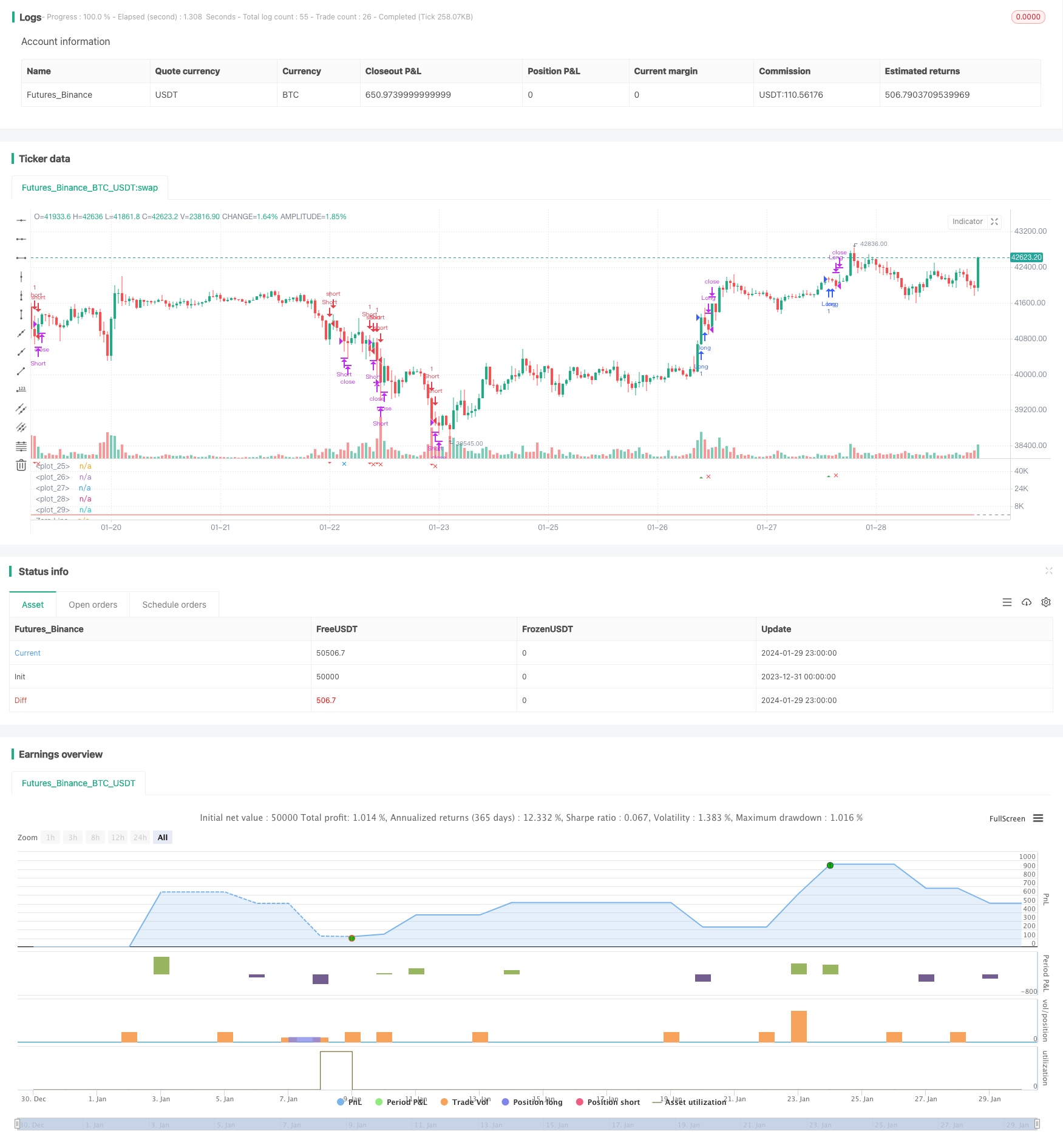
概述:这是一个应用波浪指标识别趋势的跟踪策略。它通过计算平均价格的指数移动平均线和绝对价格差的移动平均线,得到一波浪线。策略通过监控波浪线与超买超卖区域的交叉,产生交易信号。同时结合均线过滤和交易量过滤来避免错误信号。
策略原理:
计算平均价格ap=(最高价+最低价+收盘价)/3
计算n1周期的ap的EMA,得到esa
计算ap与esa的绝对差值的n1周期EMA,得到d
计算波浪线:ci=(ap-esa)/(0.015*d)
计算n2周期ci的EMA,得到终极波浪线tci,即wt1
计算wt1的4周期SMA,得到wt2
绘制超买区和超卖区的水平线obLevel1/2和osLevel1/2
当wt1上穿obLevel2线时产生买入信号;当wt1下穿osLevel2线时产生卖出信号
添加均线emaFilter和交易量volumeFilter作为过滤条件,避免错误信号
入场后设置止盈止损比例,退出持仓
优势分析:
波浪线比较好地处理了多空转换,可以有效捕捉趋势
结合均线和交易量双重过滤,可靠性较高
采用多组参数计算,避免了单一指标的局限性
设置止盈止损,可以锁定部分利润,有效控制风险
风险与缺陷:
参数的选择在某些情况下可能导致性能不佳或过度拟合
没有关于最优参数选择的明确指导,需要试错
未将更广泛的市场条件纳入信号中
如果在范围受限或波动市场中使用,存在鞭炮效应的风险
除了获利/止损之外,缺乏退出规则
优化方向:
在各种时间框架和资产上测试参数集,以找到最优值
结合波动性指标,避免在低波动性时期出现信号
添加补充指标如RSI以提高信号准确度
构建一个机器学习模型,寻找针对特定资产的最优参数
通过添加跟踪止损或基于突然的波动性扩张事件的退出来增强退出
总结:
这是一个结合波浪线和辅助指标设计的策略。它利用波浪线有效识别趋势转换的特点,辅以均线和交易量过滤来避免错误信号,能够获取大部分中长线趋势。同时采用止盈止损来控制风险。优化空间还很大,通过调整参数组合,结合更多指标,以及机器学习等方式不断改进,可以使策略在更多品种和时间周期上表现更好。
/*backtest
start: 2023-12-31 00:00:00
end: 2024-01-30 00:00:00
period: 1h
basePeriod: 15m
exchanges: [{"eid":"Futures_Binance","currency":"BTC_USDT"}]
*/
//@version=5
strategy("Bush Strategy test", shorttitle="Nique Audi", overlay=false)
// Paramètres
n1 = input(10, title="Channel Length")
n2 = input(21, title="Average Length")
obLevel1 = input(60, title="Over Bought Level 1")
obLevel2 = input(53, title="Over Bought Level 2")
osLevel1 = input(-65, title="Over Sold Level 1")
osLevel2 = input(-60, title="Over Sold Level 2")
takeProfitPercentage = input(1, title="Take Profit (%)")
stopLossPercentage = input(0.50, title="Stop Loss (%)")
// Calculs
ap = hlc3
esa = ta.ema(ap, n1)
d = ta.ema(math.abs(ap - esa), n1)
ci = (ap - esa) / (0.015 * d)
tci = ta.ema(ci, n2)
wt1 = tci
wt2 = ta.sma(wt1, 4)
// Tracé des lignes
plot(0, color=color.gray)
plot(obLevel1, color=color.red)
plot(osLevel1, color=color.green)
plot(obLevel2, color=color.red, style=plot.style_line)
plot(osLevel2, color=color.green, style=plot.style_line)
plot(wt1, color=color.green)
plot(wt2, color=color.red, style=plot.style_line)
// Tracé de la différence entre wt1 et wt2 en bleu
hline(0, "Zero Line", color=color.gray)
// Conditions d'entrée long et court
longCondition = ta.crossover(wt1, obLevel2)
shortCondition = ta.crossunder(wt1, osLevel2)
// Tracé des signaux d'achat et de vente
plotshape(series=longCondition, style=shape.triangleup, location=location.belowbar, color=color.green, size=size.small, title="Buy Signal")
plotshape(series=shortCondition, style=shape.triangledown, location=location.abovebar, color=color.red, size=size.small, title="Sell Signal")
// Conditions d'entrée et de sortie
strategy.entry("Long", strategy.long, when=longCondition)
strategy.entry("Short", strategy.short, when=shortCondition)
// Niveaux de prise de profit pour les positions longues et courtes
longTakeProfitLevel = strategy.position_avg_price * (1 + takeProfitPercentage / 100)
shortTakeProfitLevel = strategy.position_avg_price * (1 - takeProfitPercentage / 100)
// Vérification si les niveaux de prise de profit sont atteints
longTakeProfitReached = strategy.position_size > 0 and high >= longTakeProfitLevel
shortTakeProfitReached = strategy.position_size < 0 and low <= shortTakeProfitLevel
// Tracé des formes de prise de profit
plotshape(series=longTakeProfitReached, style=shape.xcross, location=location.belowbar, color=color.blue, size=size.small, title="Take Profit Long")
plotshape(series=shortTakeProfitReached, style=shape.xcross, location=location.abovebar, color=color.blue, size=size.small, title="Take Profit Short")
// Niveaux de stop loss pour les positions longues et courtes
longStopLossLevel = strategy.position_avg_price * (1 - stopLossPercentage / 100)
shortStopLossLevel = strategy.position_avg_price * (1 + stopLossPercentage / 100)
// Vérification si les niveaux de stop loss sont atteints
longStopLossReached = strategy.position_size > 0 and low <= longStopLossLevel
shortStopLossReached = strategy.position_size < 0 and high >= shortStopLossLevel
// Tracé des formes de stop loss
plotshape(series=longStopLossReached, style=shape.xcross, location=location.belowbar, color=color.red, size=size.small, title="Stop Loss Long")
plotshape(series=shortStopLossReached, style=shape.xcross, location=location.abovebar, color=color.red, size=size.small, title="Stop Loss Short")
// Fermeture des positions en cas de prise de profit ou de stop loss
strategy.close("Long", when=longTakeProfitReached or longStopLossReached)
strategy.close("Short", when=shortTakeProfitReached or shortStopLossReached)